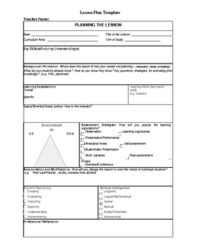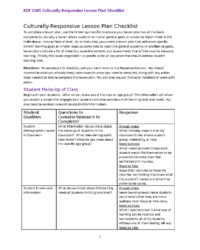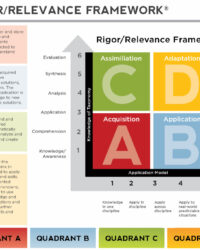Lesson planning is truly the backbone of effective teaching, guiding educators to craft meaningful learning experiences for their students. While traditional planning methods have their place, the modern classroom often benefits from a more dynamic and student-centric approach. This is where a robust framework like Bloom’s Taxonomy, especially its revised version, steps in to elevate the design of educational content and activities. It encourages a deeper consideration of what students are truly learning and how they are engaging with the material.
The revised Bloom’s Taxonomy offers a powerful lens through which to view learning objectives, shifting the focus from static nouns to active verbs that describe cognitive processes. This subtle yet significant change empowers teachers to formulate clearer, more measurable goals for their lessons, ensuring that students aren’t just memorizing facts, but truly understanding, applying, analyzing, evaluating, and creating. Integrating this revised framework into your planning via a comprehensive revised bloom taxonomy lesson plan template can transform your teaching, making it more purposeful and impactful.
Diving Deeper into the Revised Bloom’s Framework
When we talk about the revised Bloom’s Taxonomy, we’re referring to the 2001 update by Lorin Anderson and David Krathwohl, a former student of Benjamin Bloom. This revision built upon the original 1956 taxonomy, making some crucial changes that resonate deeply with contemporary educational practices. The most notable change was the shift from nouns to verbs for the cognitive levels, emphasizing active thought processes rather than static knowledge acquisition. Additionally, the top two levels, “Evaluation” and “Synthesis,” were reordered and renamed “Evaluate” and “Create” respectively, placing creation as the pinnacle of cognitive skill.
This updated hierarchy presents six distinct levels of cognitive processing: Remember, Understand, Apply, Analyze, Evaluate, and Create. “Remember” focuses on recalling information, like facts or definitions. “Understand” moves beyond recall, requiring students to interpret, explain, or summarize concepts. “Apply” involves using knowledge in new situations, solving problems, or demonstrating skills. “Analyze” means breaking down information into its component parts and understanding their relationships. “Evaluate” requires making judgments based on criteria or standards. Finally, “Create” is the highest level, where learners produce new or original work, synthesizing information in novel ways.
The power of this revised framework for educators lies in its clarity and actionable nature. By using verbs, it becomes far easier to articulate what students will *do* to demonstrate their learning. Instead of saying “Students will know about photosynthesis,” you can say “Students will *explain* the process of photosynthesis” (Understand) or “Students will *design* an experiment to test the effects of light on photosynthesis” (Create). This precision helps not only in setting objectives but also in designing appropriate activities and assessments that truly measure the desired learning outcomes.
Incorporating these levels into your lesson design encourages a progression of learning, ensuring that students move beyond surface-level understanding to deeper engagement with the material. A well-structured revised bloom taxonomy lesson plan template inherently guides you through this progression, prompting you to consider activities and assessments that align with each cognitive level, ultimately leading to more holistic and effective instruction.
Structuring Learning Objectives with Verbs
- Remember: Recalling facts, terms, basic concepts. Examples: list, name, define, recall, identify.
- Understand: Explaining ideas or concepts. Examples: describe, explain, summarize, interpret, classify.
- Apply: Using information in new situations. Examples: solve, demonstrate, use, compute, modify.
- Analyze: Breaking down information into parts. Examples: compare, contrast, categorize, differentiate, examine.
- Evaluate: Justifying a decision or course of action. Examples: judge, appraise, argue, conclude, critique.
- Create: Producing new or original work. Examples: design, compose, generate, invent, develop.
Crafting Your Own Revised Bloom Taxonomy Lesson Plan Template
Moving from understanding the theory to practical application is where the magic truly happens in the classroom. Designing your own revised bloom taxonomy lesson plan template isn’t just about filling in boxes; it’s about thoughtfully structuring your instructional approach to maximize student learning. This template serves as a comprehensive guide, ensuring that every element of your lesson is aligned with clear, measurable learning objectives derived from Bloom’s cognitive levels. It prompts you to think systematically about what you want students to achieve and how they will get there.
A robust template will typically start with basic lesson information like subject, grade level, and duration. The core, however, lies in its sections dedicated to learning objectives, which should be explicitly stated using Bloom’s action verbs. Following this, you’ll outline the instructional activities, carefully ensuring that these activities are designed to help students meet those specific objectives at the designated cognitive levels. For instance, if an objective is “Students will *analyze* primary source documents,” the activities should involve critical reading, comparison, and perhaps group discussions aimed at dissection.
Furthermore, a truly effective template incorporates sections for assessment strategies, both formative and summative, that directly correspond to the learning objectives. This means if your objective is at the “Create” level, your assessment should involve students producing something original, not just recalling facts. Finally, consider adding sections for materials needed, differentiation strategies to cater to diverse learners, and a reflection space for post-lesson analysis. This iterative process of planning, teaching, and reflecting, guided by a well-designed template, continually refines your pedagogical skills.
- Lesson Title & Subject: Clearly identify the topic and academic discipline.
- Grade Level/Audience: Specify who the lesson is for.
- Learning Objectives: State what students will be able to *do* by the end of the lesson, using action verbs from the revised Bloom’s Taxonomy.
- Materials Needed: List all resources, technology, and supplies required.
- Instructional Activities: Detail the step-by-step procedures, tasks, and discussions, aligning them with the learning objectives and Bloom’s cognitive levels.
- Assessment Strategies: Describe how student learning will be monitored and evaluated, ensuring methods align with objectives (e.g., quizzes for “Remember,” projects for “Create”).
- Differentiation/Accommodations: Outline plans for supporting diverse learners, including gifted students and those with special needs.
- Reflection Notes: A section for the teacher to evaluate the lesson’s effectiveness, what worked well, and areas for improvement.
Utilizing a structured approach to lesson planning, especially one informed by the revised Bloom’s Taxonomy, offers immense benefits. It brings clarity to your teaching goals, fosters deeper student engagement by promoting higher-order thinking skills, and ultimately leads to more effective and measurable learning outcomes. By thoughtfully designing each component of your lesson, you empower students to move beyond surface-level understanding and truly grapple with complex ideas.
Embracing this refined planning methodology transforms not just your lessons, but your entire teaching philosophy. It encourages a deliberate and strategic approach to education, where every activity and assessment serves a clear purpose in advancing student cognition. This commitment to thoughtful design helps cultivate a classroom environment where learning is not just about accumulating information, but about actively constructing knowledge and developing essential skills for lifelong success.


